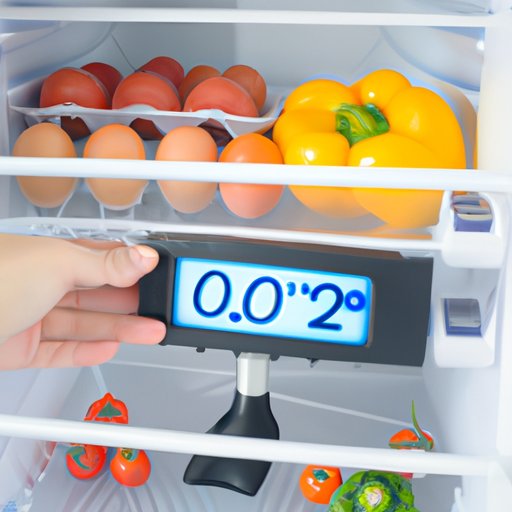Introduction
Refrigerator temperature is a crucial factor in keeping food fresh and safe. Maintaining the right temperature is essential to prevent the growth of harmful bacteria and ensure that food remains edible for longer. But what is the optimal setting for a refrigerator temperature?
Exploring the Science Behind Refrigerator Temperature: What is the Optimal Setting?
The ideal refrigerator temperature depends on various factors, including room temperature, size and type of refrigerator, and how often the door is opened. To determine the optimal temperature for your fridge, you need to take all these into account.
Factors That Affect Ideal Refrigerator Temperature
When deciding on the best refrigerator temperature, there are several factors to consider:
Room Temperature
The room temperature affects the ideal temperature for a refrigerator. In warmer climates, the recommended temperature is lower than in cooler climates. If the room temperature is higher than 70°F, the recommended temperature for the refrigerator should be between 32°F and 40°F.
Size and Type of Refrigerator
The size and type of refrigerator also play a role in determining what the optimal temperature should be. Smaller refrigerators tend to cool more quickly than larger ones, so they can be set to a slightly lower temperature. Similarly, frost-free refrigerators tend to have a higher cooling capacity than manual defrost models, so they can be set to a lower temperature.
Number of Times the Door is Opened
Opening the refrigerator door frequently increases the ambient temperature inside the appliance, which affects its cooling efficiency. The more often the door is opened, the higher the recommended temperature should be.
Average Refrigerator Temperature
The average refrigerator temperature should be between 35°F and 38°F. This range keeps food safe while still allowing it to stay fresh for longer.

How to Set Your Fridge to the Right Temperature for Maximum Efficiency
Setting the temperature of your refrigerator is an important step in ensuring that food stays safe and fresh. Here are some tips for adjusting the temperature dial:
Adjusting the Temperature Dial
Most refrigerators come with a temperature dial or knob that allows you to adjust the temperature. Generally, the colder the setting, the lower the temperature will be. It’s important to note that the temperature may not change immediately after adjusting the dial – it may take up to 24 hours for the temperature to stabilize.
Using a Digital Thermometer
To get an accurate reading of the internal temperature of your refrigerator, you should use a digital thermometer. Place the thermometer in the center of the refrigerator and wait at least 10 minutes for it to reach the correct temperature.
Testing the Temperature Regularly
It’s important to check the temperature of your refrigerator regularly. Doing this will help you make sure that the temperature is correct and that your food is stored safely.
What is the Ideal Refrigerator Temperature to Keep Food Safe and Fresh?
Keeping food at the right temperature is essential for food safety. The ideal temperature for a refrigerator is between 35°F and 38°F. At this temperature, food stays fresh for longer and harmful bacteria are unable to grow.
The Benefits of Keeping Food at Low Temperatures
Maintaining a lower temperature helps to keep food fresh for longer. Low temperatures slow down the growth of bacteria, meaning that food will stay safe and edible for longer. Cold temperatures also help to preserve the flavor and texture of food.
Recommended Temperatures for Different Types of Food
Different types of food require different temperatures for storage. Perishable foods such as meat, poultry, fish, and dairy products should be stored at 40°F or below. Non-perishable foods such as canned goods, grains, and dried fruits can be stored at room temperature.

An Overview of Different Refrigerator Temperatures and Their Benefits
The optimal refrigerator temperature varies depending on the type of food being stored. Here is an overview of the most common settings and their benefits:
Refrigerator Temperature Settings
- 0°F to 32°F: This is the coldest setting and is best for storing frozen foods.
- 33°F to 40°F: This setting is ideal for storing perishable foods such as meat, poultry, fish, and dairy products.
- 41°F to 50°F: This setting is best for storing non-perishable items such as canned goods, grains, and dried fruits.
Advantages of Lower Temperatures
Lower temperatures help to keep food fresh for longer and reduce the risk of foodborne illnesses. They also help to preserve the flavor and texture of food.
A Guide to Adjusting Your Refrigerator Temperature for Maximum Performance
Adjusting the temperature of your refrigerator is an important step in ensuring that food stays safe and fresh. Here are some tips for adjusting the temperature dial:
Steps to Take When Adjusting the Temperature
- Set the dial or knob to the desired temperature.
- Wait for the temperature to stabilize (this may take up to 24 hours).
- Use a digital thermometer to check the internal temperature of the refrigerator.
- Test the temperature regularly to make sure it is correct.
Tips to Maintain the Temperature
- Keep the refrigerator door closed as much as possible to maintain the desired temperature.
- Avoid putting hot food directly in the refrigerator, as this can cause the temperature to rise.
- Clean the condenser coils regularly to ensure the refrigerator is running efficiently.
Conclusion
Refrigerator temperature plays an important role in keeping food safe and fresh. The optimal temperature for a refrigerator is between 35°F and 38°F. To achieve this, you need to take into account factors such as room temperature, size and type of refrigerator, and how often the door is opened. By taking these steps, you can ensure that your food is stored safely and at the right temperature.
Maintaining a lower temperature helps to preserve the flavor and texture of food and reduce the risk of foodborne illnesses. Additionally, regular testing of the temperature can help to ensure that your food is stored correctly. By following these guidelines, you can maximize the performance of your refrigerator and keep your food safe and fresh.


